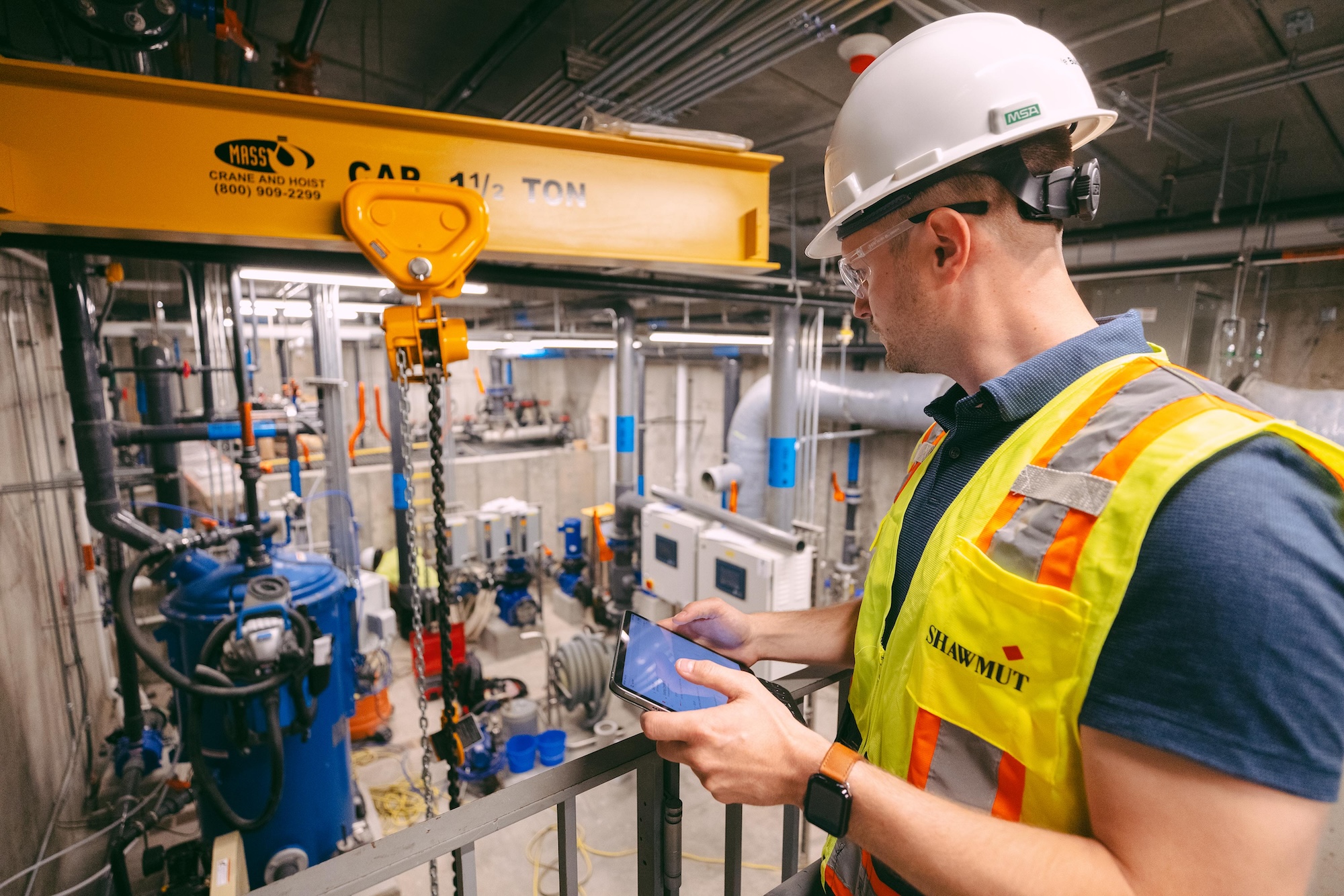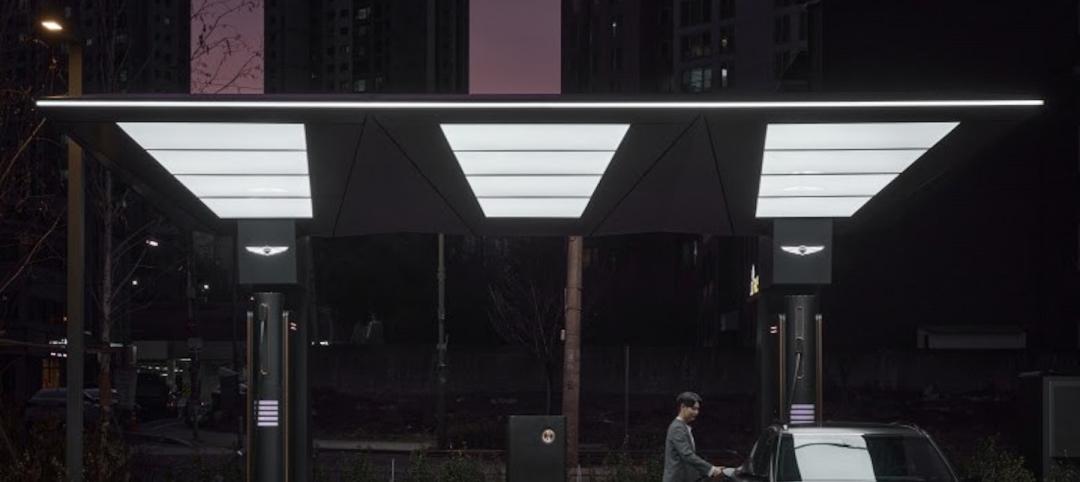Last October, Turner Construction held its annual Innovation Summit in New York. The theme of the three-day event was “From Artificial Intelligence to Intelligence Augmentation.” Among the AI solutions and practices presented, Turner demonstrated an AI tool (first tested by the firm’s procurement team in Vancouver, B.C.) that automates the drafting of contracts, a potential major time-saver for a company that issues about 30,000 trade contracts per year.
Turner’s Engineering Group has been leveraging AI to facilitate rapid design iteration. And over the past few years, the company has been recommending Versatile.ai’s CraneView, a device attached to a crane hook that captures jobsite data and uses machine learning to measure performance and efficiency.
“What we’ve said is ‘here’s something we think works,’” says Turner spokesperson Chris McFadden. The firm has found that jobsites which require tower cranes are more likely to use CraneView.
Turner is among the AEC firms that are trying to figure out where artificial intelligence fits into their operations. For some, the future is now. “AI is up and down our tech path,” says Kelly Benedict, Gilbane Building Company’s Head of Innovation and Transformation, whom BD+C interviewed with Rawle Sawh, the firm’s Director of Operations and Technology. Over the past five years, the GC Suffolk has made “several interesting bets” on using AI for predictive analysis and modeling, says Kelsey Gauger, the firm’s National Director of Operational Excellence.
AEC firms, though, are still cautious in their evaluations of new products entering the market and their claims about what AI can do, especially when it comes to Generative AI. “‘Al-enabled’ has become like ‘all-natural’ in the food industry,” quips Michael Zeppieri, Vice President with Skanska USA’s Emerging Technology Team. His colleague, Danielle O’Connell, the team’s Senior Director, admits that she’s both “excited and nervous” about AI’s potential.
But they and other AEC sources are also mostly optimistic that AI will become a useful and widely used design, construction, and management tool. “AI will help thousands of construction companies currently struggling to meet deadlines and reduce costs by streamlining data collection, enhancing data accuracy, and improving data analysis,” George Goubran, Co-CEO of Built On Vision, a project management software provider, told Engineering.com in an interview posted last September.
It began with using AI to mitigate risk in construction
A common introduction to AI for AEC firms has been to use it to help detect and, wherever possible, prevent jobsite injuries. In 2018, for example, Suffolk conducted a test case using Newmetrix’s AI engine, nicknamed Vinnie, to automatically analyze a decade of images from construction management systems like Procore and Autodesk BIM 360, as well as site-camera data from OxBlue cameras. The case study also evaluated every safety incident on Suffolk’s jobsites over 10 years to develop a predictive model.
Josh Kanner, Senior Director of Product and Strategy–Construction Intelligence Cloud for Oracle, which acquired Newmetrix in October 2022, says that Vinnie’s predictions were assessed for their accuracy of early-warning alerts and by the number of incidents the alerts caught. The test predicted 20% of incidents with 80% accuracy. Kanner says that if 25% of incidents were detected, a hypothetical company with at least 50 projects would prevent between 40 and 100 incidents and save between $1.4 million and $3.6 million per year in risk abatement.
Shawmut Design and Construction has been working with Newmetrix (formerly known as Smartvid.io) since 2016, first by collecting imagery for safety compliance issues (wearing protective gear, working from heights, evidence of standing water, etc.). In 2019, Shawmut developed an AI-enabled predictive tool. As images were uploaded, they would be analyzed against other jobsites, and that analysis has formed the basis of weekly reports that identify 12 hot spots, about which Shawmut reaches out to its project teams. The risks identified could range from weather events to the number of people on a jobsite. Shawmut and its project teams then come up with responses. “I see this tool as being mostly observational; it’s completely passive and most employees don’t even know it’s happening,” says Shaun Carvalho, Shawmut’s Chief Safety Officer.

More recent uses of AI can be found at the AO-designed Mountain View Village in Riverton, Utah, which has a water feature that’s controlled by a patented AI system supplied by Outside the Lines (OTL), whose CEO, Wick Zimmerman, says this was his company’s first foray into AI. The touchless system uses machine learning principles to detect users’ presence, position, and motion, and responds with displays of water, lights, and other effects. Zimmerman anticipates that future iterations of this system will be able to recognize movements of larger crowds—say, flash mobs—and create spontaneous, coordinated lighting and music effects.
Last November, two of Gilbane’s project teams began piloting a large-language model that helps those teams retrieve construction documents “within seconds,” says Benedict. The AE firm LEO A DALY is using Microsoft’s Copilot Chat product (which is now embedded in Microsoft Teams) for summarizing meeting minutes and organizing those notes into bullet points. Using software from a startup, LEO A DALY is also leveraging AI for proposal writing, says Stephen Held, the firm’s Vice President and Chief Information Officer.
The firm has been capturing jobsite imagery for several years, and uses AI to compare those images with existing conditions and LEO A DALY’s expectations. “The analysis is what we’re really interested in, and we’re looking to spot differentials and variables” in infrastructure like earth movement or trenches, says Held.
Suffolk has also rolled out Copilot, which Gauger says ties into his firm’s SharedPoint suite of tools to call up information and answer questions for workers in the field. Suffolk recently hired Murat Melek, PE, SE, as its Director of AI, who is working with its Suffolk Design division’s 30 architects, and drawing on the feedback loop from past projects to make better design decisions.
Gauger predicts that AI and robotics are likely to intersect at some point. At its 634,000-sf 10 World Trade project in Boston, Suffolk has teamed with Rugged Robotics and Feldman Geospatial to develop a robot that prints floor topography onto a slab using data fed into the robot that brings the coordinated layout drawing to the field. The goal is to significantly reduce the estimating cost of floor finishing in commercial construction. Gauger thinks it’s only a matter of time before robots with enough data can lay out entire buildings. “The use of AI in construction is only beginning,” says Gauger.
Generative AI still a hurdle in the construction industry
At times it appears that the applications for AI have no bounds. According to FedScoop.com, the U.S. government has identified more than 700 uses for AI technology. The website writerbuddy.ai estimates that the AI industry experienced a 10.7-times growth rate in 2023, with ChatGPT receiving more than 60% of the 24 billion industry visits observed.
But AEC firms say that achieving true Generative AI is still limited by the quality and quantity of project and design data available, as well as by the ability of AEC firms and their ConTech partners to marshal that information.
Of course, the software providers see a glass that’s more than half-full. “Generative AI pilot projects will increase, especially in the design phase,” asserts Usman Shuja, Bluebeam’s CEO. “AI can help bring order and clarity to project execution in a time where projects are getting more complex and deadlines are getting shorter.”

Oracle is working with a company called Cohere, which competes with Open AI’s ChatGPT, to build a Generative AI prototype for the scheduling process whose functionality would include summarizing RFPs. (Oracle is beta-testing this with contractors.) “The good thing about GenAI is that you don’t need new data to use it,” says Kanner.
Machine learning and AI are now built into Autodesk’s Construction IQ suite of products that predict and manage risks to cost, schedule, quality, and service.
As one of seven startups chosen for the latest cohort in Suffolk Technologies’ BOOST accelerator program, Trunk Tools is developing a new product, TrunkText, a text message-based AI tool and web app designed to make accessing project information easier for construction professionals by texting project questions and receiving accurate answers in a few seconds—versus the hours such searching would take manually. DPR Construction is among the firms championing this technology.
However, when it comes to vetting products, especially for Generative AI, LEO A DALY is “definitely in the trust-but-verify mode, because right now the industry is in a hype cycle,” says Held. “AI-enabled text is coming along magnificently. But GenAI is a bigger challenge, partly because there’s not enough data to look at, so that models [created] aren’t consistent.” His firm belongs to the Innovation Design Consortium, which has been urging its 40 members to share data.
When interviewed in November, Skanska’s O’Connell said her firm was looking at products with an AI component from 50 vendors. Skanska’s selection criteria start with:
• What problem is the tool designed to solve?
• Does a variation of the product already exist?
• Can it have a greater impact on the company’s overall productivity?
O’Connell says Skanska also wants to know if the vendor “understands our tech stack” so that the AI product can be easily integrated into what jobsite workers are already comfortable with, like Procore. “We want to know the learning curve, because if it’s a barrier to adoption, it might be better that we continue doing things how we do them now,” added Zeppieri.
Gilbane, says Benedict, isn’t interested in AI products that simply “automate complexity.” The firm’s Spark team, which vets emerging tech, is Gilbane’s “first line of defense,” and has been very selective in choosing the software it’s willing to pilot. (So far, only a small handful of the pitches it has listened to have made it to the pilot stage. The results from those pilots, says Sawh, have been “favorable, but mixed.”)
Shuja, who recently joined Bluebeam from the Austin, Texas-based AI platform builder SparkCognition, recommends that AEC firms look at new AI products through three lenses:
• Does AI solve a pain point in ways that enable a competitive advantage?
• What data is needed to optimize the software?
• How will the software be implemented and adopted?
Scheduling could be ‘next horizon’ for AI in construction
Despite any caveats, most AEC firms expect AI to become more important to their operations, even as they may be less sure about where it will take their companies. “It is clear that AI and other technologies can refine operations, heighten sustainability, reduce risks, and foster positive transformation within the built environment,” says Kris Wahl, Turner Construction’s Innovation Manager.
Predictions about the future depend on how far these firms have traveled the AI path. Some will go out on a limb, like Dan Hollencamp, COO of Toggled, which makes building control systems, who foresees AI’s influence on smart building management leading to buildings that can self-correct based on a continuous loop of energy data reporting and optimization.

That prospect of AI’s increasing self-awareness, though, is exactly why more than a few people want its usage corralled. Their fear of what AI might become could also explain why most AEC prognosticators interviewed are reserved in their crystal balling. Shuja expects three trends to emerge in 2024: AI finds more practical and ethical applications. The technology is subject to regulation. And continued industry digitization drives sustainability.
The “next horizon,” says Oracle’s Kanner, could be a set of tools that is AI-enabled “from the ground up,” makes access to information easier, and “puts humans at the center of checking the work.” Skanska’s O’Connell sees AI being useful for knowledge sharing, and for automating predictive safety notifications. (She recently was on a call with a webcam vendor whose product helps detect potential fires hazards in buildings, which O’Connell thinks could make mass timber projects safer.) Shawmut’s Carvalho wants AI that refines his firm’s notification system so that it can provide real-time details about potential risks.
Gilbane’s Sawh says his firm would be looking for AI solutions that impact multiple parts of its business, like predicting how many workers are needed to complete part of a project on schedule. “We’re not quite there yet,” he concedes. Benedict adds that the next stage of AI for construction should include protecting a project’s intellectual property and data. She believes the industry would be wise to establish governance around cybersecurity.
Held of LEO A DALY agrees, given that the firm has been hit by AI phishing attacks, and that he also expects the evolution of this technology to be able to generate construction documents and design templates.
When asked if the application of AI might lead to greater design standardization, Held says the word he keeps hearing from developers is “recipe” as opposed to striving for unique or different design ingredients for every project.
Held believes that, ultimately, AI will create jobs, and that the mix of employees will become more diverse. He says LEO A DALY will need to hire more programmers, and people with backgrounds that combine architecture with deep data analysis and AI skills. “I haven’t written the description for that job yet.”
More recent BD+C news on AI in construction:
Related Stories
AEC Tech | Apr 13, 2022
Morphosis designs EV charging station for automaker Genesis
LA-based design and architecture firm Morphosis has partnered with automotive luxury brand Genesis to bring their signature brand and styling, attention-to-detail, and seamless customer experience to the design of Electric Vehicle Charging (EVC) Stations.
AEC Tech | Apr 13, 2022
A robot automates elevator installation
Schindler—which manufactures and installs elevators, escalators, and moving walkways—has created a robot called R.I.S.E. (robotic installation system for elevators) to help install lifts in high-rise buildings.
Hotel Facilities | Apr 12, 2022
A virtual hotel to open in the metaverse
A brand of affordable luxury hotels that launched in 2008, citizenM has announced it will purchase a digital land site in The Sandbox, a virtual game world owned by Animoca Brands.
Modular Building | Mar 31, 2022
Rick Murdock’s dream multifamily housing factory
Modular housing leader Rick Murdock had a vision: Why not use robotic systems to automate the production of affordable modular housing? Now that vision is a reality.
AEC Tech Innovation | Mar 9, 2022
Meet Emerge: WSP USA's new AEC tech incubator
Pooja Jain, WSP’s VP-Strategic Innovation, discusses the pilot programs her firm’s new incubator, Emerge, has initiated with four tech startup companies. Jain speaks with BD+C's John Caulfield about the four AEC tech firms to join Cohort 1 of the firm’s incubator.
AEC Tech | Feb 11, 2022
Trimble Dimensions+ 2022 Call for Speakers Now Open
Trimble has opened its Call for Speakers for the Trimble Dimensions+ 2022 User Conference, which will be held November 7-9 at the Venetian Resort in Las Vegas.
Coronavirus | Jan 20, 2022
Advances and challenges in improving indoor air quality in commercial buildings
Michael Dreidger, CEO of IAQ tech startup Airsset speaks with BD+C's John Caulfield about how building owners and property managers can improve their buildings' air quality.
Architects | Dec 20, 2021
Digital nomads are influencing design
As our spaces continue to adapt to our future needs, we’ll likely see more collaborative, communal zones where people can relax, shop, and work.
AEC Tech | Dec 16, 2021
Autodesk to Acquire Cloud Based Estimating Company ProEst
Autodesk, Inc. is acquiring ProEst, a cloud-based estimating solution that enables construction teams to create estimates, perform digital takeoffs, generate detailed reports and proposals and manage bid-day processes. Autodesk plans to integrate ProEst with Autodesk Construction Cloud, a comprehensive construction management platform connecting teams, data and workflows across the entire building lifecycle.
Urban Planning | Dec 15, 2021
EV is the bridge to transit’s AV revolution—and now is the time to start building it
Thinking holistically about a technology-enabled customer experience will make transit a mode of choice for more people.
















